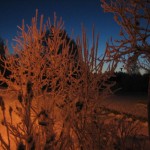
Last June, during the International Polar Year conference, James Overland suggested that there are more cold and snowy winters to come. He argued that the exceptionally cold snowy 2009-2010 winter in Europe had a connection with the loss of sea-ice in the Arctic. The cold winters were associated with a persistent ‘blocking event’, bringing in cold air over Europe from the north and the east.
Last year’s cold winter over northern Europe was also associated with an extreme situation associated with the North Atlantic Oscillation (NAO), with the second lowest value for the NAO-index on record (see figure below).
I admit, last winter felt quite cold, but still it wasn’t so cold when put into longer historical perspective. This is because I remember the most recent winters more vividly than those of my childhood – which would be considered to be really frosty by today’s standards. But such recollections can be very subjective, and more objective measurements show that the winters in Europe have in general become warmer in the long run, as explained in the German blog called ‘Wissenlogs’. If there were no trend, then such a low NAO-index as last year’s would normally be associated with even colder conditions over Europe than those observed during the previous winter.
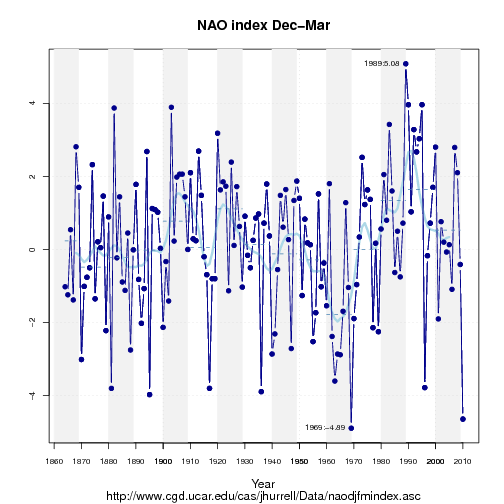
In a more recent press-release, Vladimir Petoukhov and Vladimir Semenov, argue that Global Warming could cool down winter temperatures over Europe, and a reduced sea-ice extent could increase the chance of getting cold winters. Also they propose that cold winters are associated with the atmospheric circulation (see schematic below), and their press-release was based on a paper in Journal of Geophysical Research (JGR), which may seem to have a serendipitous timing with the cold spell over Europe during the last weeks. However, the original manuscript was submitted in november 2009 (before the statement made by James Overland) and accepted in May 2010. One could regard the paper more as a ‘prediction’ rather than an ‘explanation’.
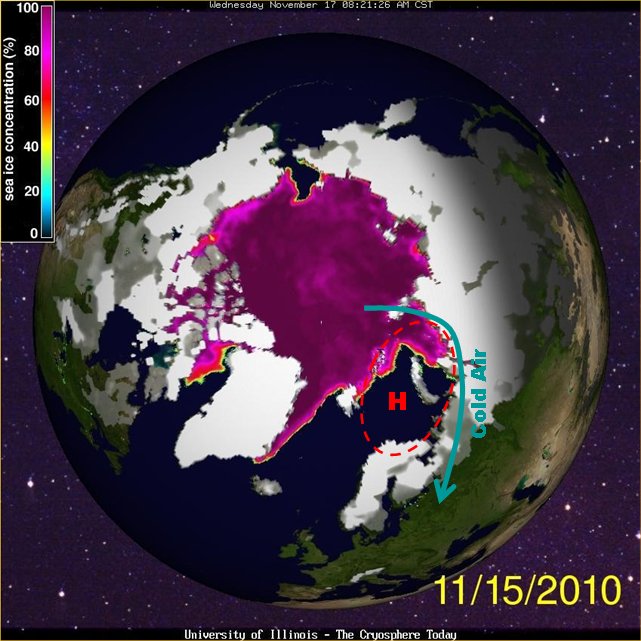
Although Petoukhov and Semenov’s findings sound plausible, I don’t think they are as straight-forward as they initially seem in terms of their implications for this winter either. For one thing, it is impossible to prove that one single event is due to a change in the long-term, as we pointed out for the case of hurricanes (The 2010 hurricane season this year, by the way, was quite active).
I think it is important to keep in mind that the Petoukhov and Semenov study is based on a global atmosphere model that simulated a non-linear response to the loss of sea-ice in the Barents-Kara seas: initially warm winters, followed by cold, and then warm winters, as the sea-ice extent is gradually reduced.
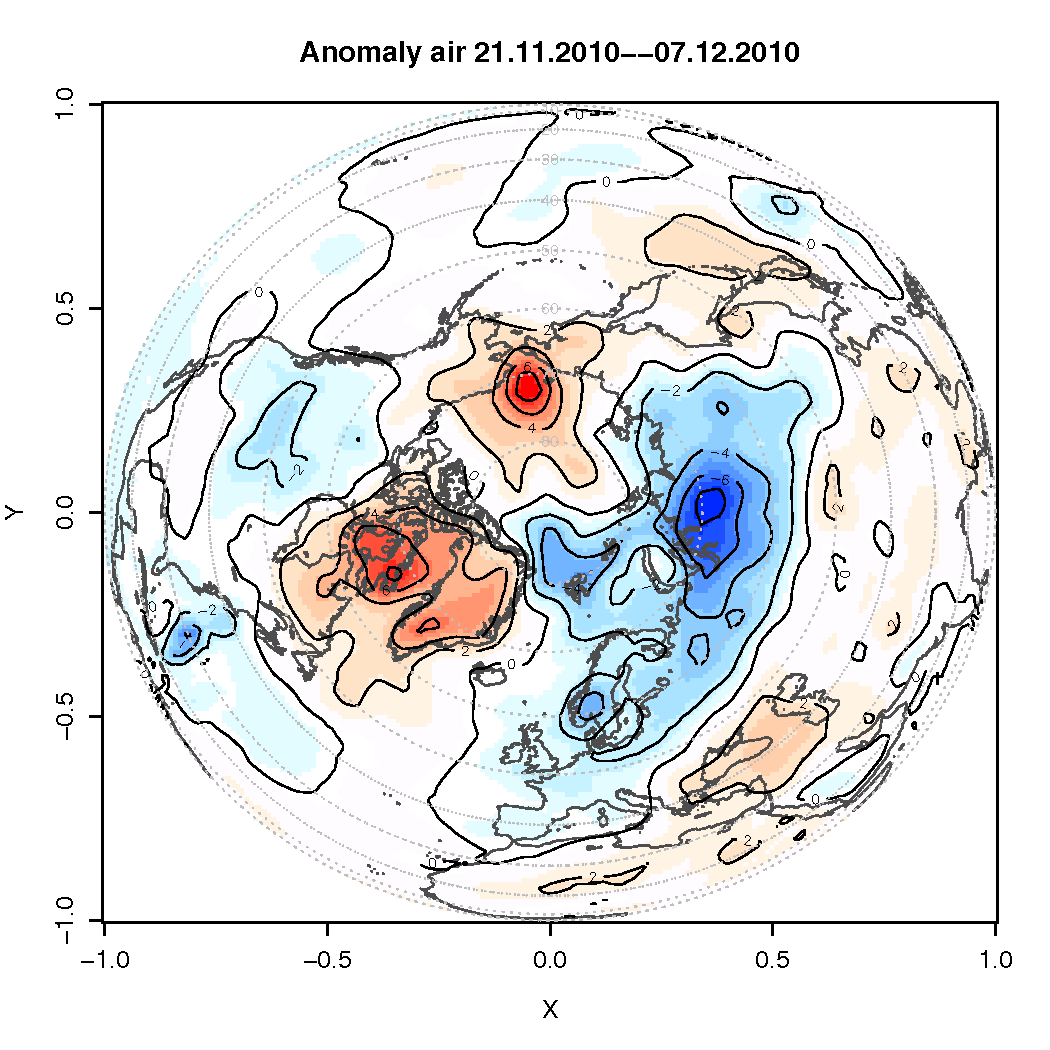
One interesting question is how the Barents-Kara sea-ice affects the winter temperatures over the northern continents. By removing the sea-ice, the atmosphere above feels a stronger heating from the ocean, resulting in anomalous warm conditions over the Barent-Kara seas. The local warming gives rise to altered temperature profiles (temperature gradients) along the vertical and horizontal dimensions.
Changes in the temperature profiles, in turn, affect the circulation, triggering a development of a local blocking structure when the sea-ice extent is reduced from 80% to 40%. But Petoukhov and Semenov also found that it brings a different response when the sea-ice is reduced from 100% to 80% or from 40% to1%, and hence a non-linear response. The most intriguing side to this study was the changing character of the atmospheric response to the sea-ice reduction: from a local cyclonic to anti-cyclonic, and back to cyclonic pattern again. These cyclonic and anti-cyclonic patterns bear some resemblance to the positive and negative NAO phases.
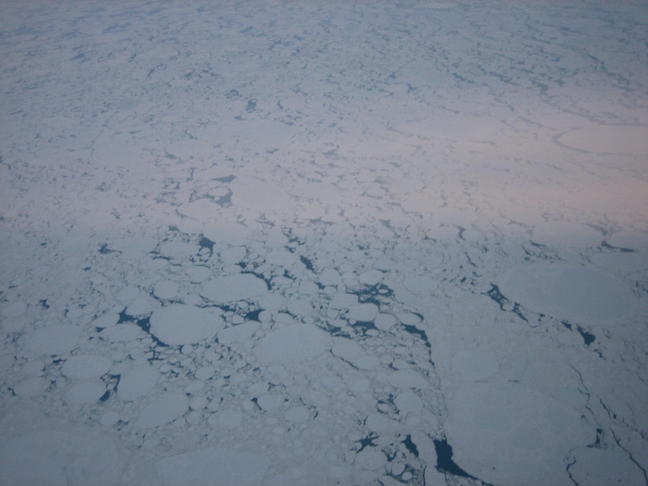
They also show a different response in surface air temperature (SAT) during December, January, and February. From their Figure 2, it is not immediately obvious from that figure that a sea-ice reduction leads to lower SAT during January. This is, however, very much in line with similar analysis that I have carried out with colleagues and struggled to find a consistent response (albeit we looked at the summer season).
But Petoukhov and Semenov provide theoretical support for their observations, and argue that the non-linear response can be explained in terms of ‘convectional-frictional’ and ‘baro-clinic-frictional’ mechanisms. The former includes warming over the areas where sea-ice disappear, and changes in the vertical temperature gradients, stability, and hence friction, while the latter involves a change in the surface friction force associated with temperature changes over distances.
I think that the scientific community will need some time to confirm this link, and there are some
important caveats: For one thing, the spatial model resolution (the size between the boxes in the grid mesh, through which the models represent the world) has an influence on their ability to represent blocking frequency. Hazeleger et al. Has observed that “… different horizontal resolutions … confirm the resolution-dependence found in NWP [Numerical Weather Prediction]”. The atmospheric model used by Petoukhov and Semenov has a fairly coarse spatial resolution (2.8 degrees x2.8 degrees), and it is legitimate to question whether it can reproduce the
frequencies of blocking events realistically, and whether that has a bearing for the conclusions.
But also the fact that the sea-surface temperatures (SSTs) were fixed in these experiments may affect the conclusions. Balmaseda et al. found that the atmospheric response to changes in sea-ice conditions may depend on the background SSTs, at least for the summer months. They also compared results from a coupled ocean-atmosphere model with the results from an atmosphere model for which the SSTs were given. Their unexpected finding was that the atmospheric response in these two cases were very different.
In fact, global atmospheric and climate models are better at describing the large picture than more regional and local characteristics. There is a limit to what they are able to describe in terms of local regional details, and it it reasonable to ask whether the response to changes in regional sea-ice cover is beyond the limitation of the global model. If different models give different answers, then it is likely that the response is not robust.
Another interesting question is whether the sea-ice the is whole story. Not long ago, there were some suggestions of a link between low solar activity and cold winters (this correlation, however, is so weak that you would never notice without statistical analysis. Also see comment here). Do these factors affect the circulation patterns over the North Atlantic? The sunspots tend to vary on a time scale of 10-12 years, but the NAO-index suggests that few of the extreme low values were repeated over two subsequent years. In other words, the NAO doesn’t show the same persistence as the sunspots. It will be interesting to see if this winter will break with previous patterns – if it does, that could be interpreted as a support of Petoukhov and Semenov hypothesis.
It is nevertheless no contradiction between a global warming and cold winters in regions like Europe. Rather, recent analysis suggest that the global mean temperature is marching towards higher values (see figure below), and Petoukhov and Semenov argue that the cold winter should be an expected consequence of a global warming.
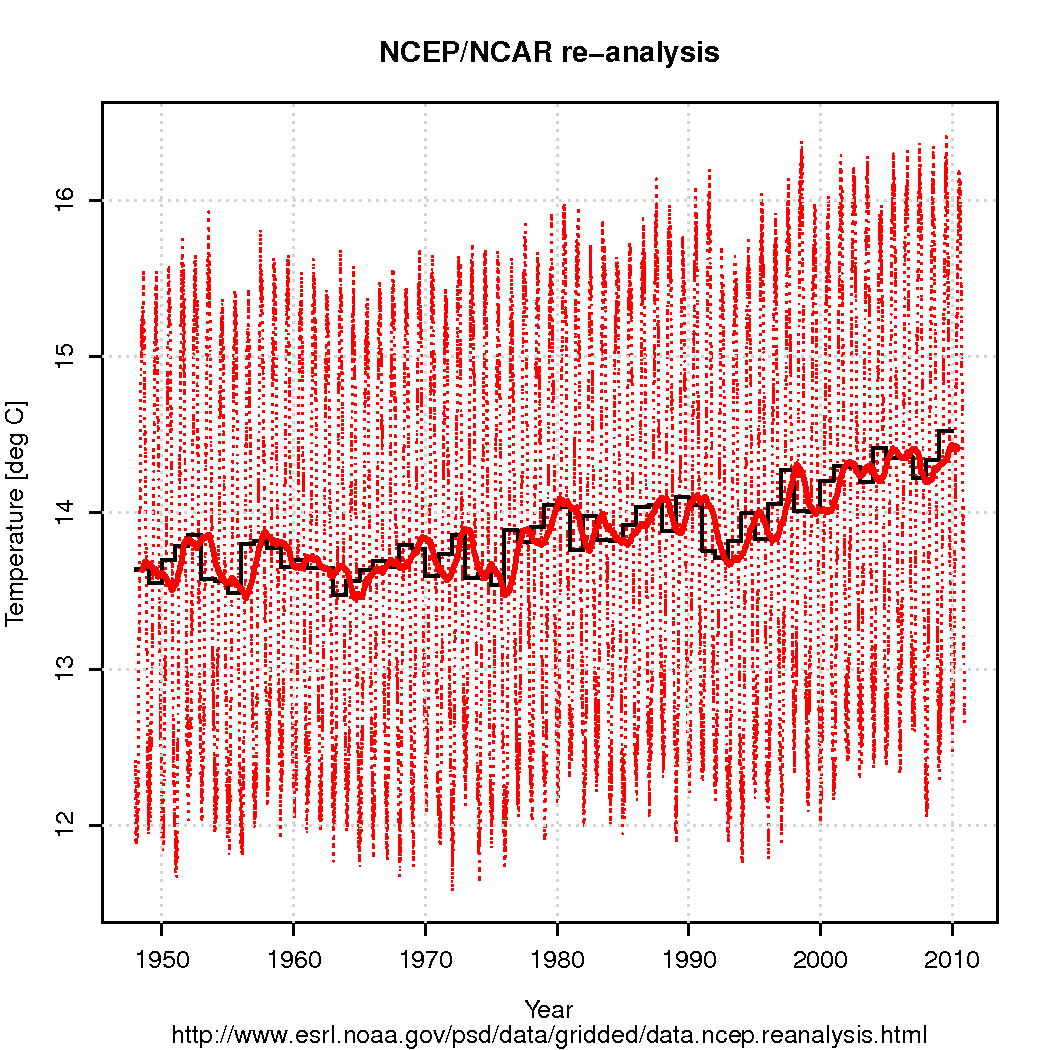
Didactylos, in all due respect, that often (but not always) veiled deniability and rationale is about as subtle as a train wreck.
Maya in the peanut gallery, it was just a friendly jab…
“Dr. Shooshmon, phd” is an obvious trollbot. See for example here, Comment #62013:
Recognise the style? Semi-literate, “factual” statements with no references that are obviously false, and claims that are bound to raise the ire of anyone with a clue.
Shooshmon #365, referring to atmospheric CO2: “… historically it is negative decrease.”
Indeed.
The negative CO2 decrease is not uncorrelated with a negative cooling. Which is, like, uncool.
(With apologies to Orwell and e.e. cummings: The human impacts are potentially doubleplusungood — but pity this busy monster, manunkind, not.)
Rod B: What are you talking about?
[edit – OT, just one set of denialist talking points at a time please]
This may be relevant to the original post (if not to the thread, which seems to have travelled a remarkable journey all the way to discussing how much the collective dinosaur population ate!)…
The Jan 2011 issue of Weather is now online and is a special issue about winter 2009/10. Mostly from a UK perspective. I haven’t read them all yet, but I don’t think any deal with the particular question of whether reduced Arctic sea-ice cover might cause the anomalous atmospheric blocking circulation that is linked with cold winters in parts of Europe. But nevertheless they may be of interest.
http://onlinelibrary.wiley.com/doi/10.1002/wea.v66.1/issuetoc
You probably need a paid subscription to read these articles — sorry! For those without a personal or institutional subscription, here is the final paragraph of my article:
Similar results have been reported by others.
Hope it’s not too early to wish you all a happy new year — especially to my friends at RealClimate!
Tim
Didactylos, I was referring to your #383, and commenting on the prevalence of some that proclaim loudly, “See that big hurricane??!!? [or fill in the blank with any one of a plethora of regional weather examples] Global Warming!!! Global warming!!!” Then when called on the logic mutter some gibberish about “not really causation… just giving examples….. no, just a possible scenario… something else… ” or some other back peddling. Then in a later thread attempt the same meme.
Rod B: No excuse for perpetrating the opposite error.
Life would be a lot simpler if we could just filter out the babbling of the extremists and their black and white views.
The opposite of “denier” may very well be “warmist”, but neither have anything interesting to say about climate. The vast majority of commenters here, however, are capable of grasping nuance, and of distinguishing nonsense from unclear science and from well-established science. We agree with the consensus view because it makes sense, not because of dogma.
We can cope with the idea that warmer global temperatures should make local record highs more frequent, and heatwaves more frequent.
Can you?
D, Rod has these themes he will always bring up regardless of the discussion.
No cite; it’s tasty bait to get people talking about his issue instead.
CM,
I love it! You are a true epophessagr–I mean, prophet!
Didactylos, I agree with most, maybe even all, of your #409. I explicitly did not target everybody here with my accusation — hence the words “some” and “often.” Which would mean that some are not at all guilty. (Whether a vast majority or not I can’t say.)
I certainty can cope with “the idea that warmer global temperatures should make local record highs more frequent, and heat waves more frequent.” But not that GW caused 1) Katrina, 2) the European heat wave a few years back and the recent European cold wave, 3) Charlie’s peach blossoms to bud out two weeks earlier than last year, 4) an Australia drought last year and flooding this year, 5) the recent unprecedented Moscow heat wave and the more recent Moscow uncommon winter blast, etc., etc., etc. But there are those (some) here that really try to convince people of such.
Hank, I don’t bother with specific cites because they would be too time and space consuming. But you can easily find them here in RC — don’t even have to google for them! ;-)
Rod B., not to pull on the shoe loudly proclaiming the excellence of the fit or anything, but when I’ve cited Katrina and the ’03 heatwave (more often elsewhere than here) I’ve been as clear as I know how to be that they can’t be formally attributed to climate change–but that they are exemplary of what the future may be expected to look like under BAU.
And they are certainly worth recalling when someone claims that “nothin’s happnin’.”
Now this article is truly amazing to see at Realclimate.org. Only one single cold winter and a really cold start of another one makes the great general holy consensus crumble at the edges. How wonderful observations are!
The idea of colder winters in Europe in a warmer world is not new, of course. But this is the first time I see it taken seriously in a believers forum like this and the reason was just mentioned – real observations. But don’t forget that the IPCC AR 4 is very clear on its predictions for central and northern Europe, it will be one of the areas outside the polar ones that will warm most and it is the winter more than the summer that will become warmer.
Most of the 21st century winters have also been mild or even very mild in this region. This has helped a lot to sell in the global warming message. Although the real scientists have typically been careful in not saying too much they have nodded and noted that this trend is what is expected of the AGW scenario. Last year everything changed. Suddenly there was a really cold winter although not exceptional. How come? All sorts of indices started to appear in the general media such as NAO and AO. Fair enough, but how come that they were essentially NEVER mentioned in popular media as an explanation for the preceding warm winters?
[Response: Your research on this matter is extremely partial. NAO/warm winter discussions were plentiful over the last decade. Pretending that this is the first you’ve heard of it is good rhetoric, but bad science. – gavin]
Now this winter has begun. This one is so far something completely different. This one IS exceptional and many regional records of various kinds (persistent cold, area of snow coverage etc.) have been set, in some cases in series more than one or two centuries old. Not so easy to explain away. Now the situation is more serious – how to reconcile this with the idea of a warming world? One should also not forget that the global measurements since 12 years back show not a warming world but rather a constant temperature world although in a relatively short period as 12 years random fluctuations could be important.
There was a paper recently by Cattiaux and coworkers recently
(http://sciences.blogs.liberation.fr/files/cattiaux_et_al_grl2010.pdf)
that tried to describe last winter in terms of flow analogues. They argue that last winter was cold but should in reality have been even colder in absence of AGW, and that it was mainly due to an extremely negative NAO. An important point in their reasoning was that last winter was not very cold after all. Well, this one is (so far – but the long term predictions say cold or very cold). I don’t dare to think how cold it could have been without AGW!
The present note should be seen in this light. But the science is settled is the message we get from this blog. OK. But how come then that the model for Europe may be completely wrong?
This is important indeed. And why did it take only little more than one winter to dig up the ideas? And if Europe was this completely wrong how do we know it doesn’t go for other regions too? And for the whole global model? (If Europe and more is indeed wrong then the global models simply have to be affected to some degree even if the original overall picture was correct).
To me this gives the impression of a very unsettled science. This in no way a surprise, this is what I and most sound critics have been saying all the time. The science may be the best possible but the uncertainties far greater than claimed. Many countries in Europe are already spending billions for actions that should help them handle a warmer climate. If the opposite is true then much of this isn’t only wasted, it may even be harmful. This is just a perfect illustration of how unwise it is to take action before you have the full picture.
Maybe the snowplough budget at Heathrow was already adapted to an expected warm up when reality struck a few weeks ago? And similarly perhaps in New York which Gavin, if I am rightly informed, just needs to look out the window to see the consequences of.
The latest frost fair on the Thames in London was held in 1814. One wonders what the flow patterns said then? See you perhaps at the coming one next February?
[Response: I’ll happily bet serious money, even with odds, that no frost fair will be held on the Thames in London in February. Just because you keep talking about cooling doesn’t actually make it cool you know… – gavin]
Gavin’s comment to #414. Gavin doesn’t believe in a London frost fair next year either. So what killed them, in your opinion? It certainly wasn’t fossil fuel driven AGW, that started only many many decades later.
#412 “I don’t bother with specific cites because…”
You don’t have cites — and when you can’t avoid admitting the fact, you disappear for a few days or weeks.
If you had a shred of intellectual honesty, you’d provide the sources behind your statements.
Lucky you: Being a troll means never having a sense of accountability.
Steven Jorsater,
Do you have some sort of reading comprehension problem? Or perhaps, as with most things, you just didn’t bother to read the original post and decided to “wing it” uninformed?
The post is in response to a specific paper–and one at the cutting edge of climate science, rather than the well established like climate change itself. Perhaps you are not interested in science. Some of us are.
News Flash, Punkin: Not everything needs to be veiwed through your rose-colored blinders of politics.
But the science is settled is the message we get from this blog. – Steven Jörsäter
So you’re a careful reader of this blog?
https://www.realclimate.org/index.php/archives/2009/12/unsettled-science/
I can remember a whole bunch of times when the people who run this blog have strongly emphasized unsettled science, the unknowns, the uncertainties, where more work needs to be done, where time needs to pass so more research can come in, etc.
But then, obviously, I don’t read as carefully as you do.
Steven Jörsäter – The Thames was broader and shallower before the early 19th century, which is a lot of the reason it ocassionally froze over, and even then sometimes only for very short periods … there were only 26 years it froze over a period of 500 years, why is it any indicator of anything?. Do you have a reliable reference to this current December being “exceptionally” cold in England for “one or 2 centuries”? compare your assertions here.
> … what killed them
http://www.icons.org.uk/theicons/collection/the-thames/features/frost-fairs
“All sorts of indices started to appear in the general media such as NAO and AO. Fair enough, but how come that they were essentially NEVER mentioned in popular media as an explanation for the preceding warm winters?”
Well, according to Dave Barry “We journalists make it a point to know very little about an extremely wide variety of topics; this is how we stay objective.”
[Response: :) Said as only Dave can say it…–Jim]
What is the thinking about how December ranks? could make this year first or second in the records.
back to Cold winter in a world of warming:
Rossby waves from the top: There are 4 waves circling the North Pole. One wave consists of a high pressure area and a low pressure area. That is 8 pressure areas in a ring around the pole at the latitude of Canada. Between the pressure areas are flows north and flows south.
Between a clockwise rotation and a counterclockwise rotation [left to right] the flow is from the north to the south at ground level. The reverse is true between a counterclockwise rotation and a clockwise rotation. Every quarter rotation, the flow is north. In between those flows at 45 degrees + quarter rotations, the flow is south.
So, by rotating the Rossby wave system 1/8 turn [45 degrees] with respect to the Earth, the flow at a certain point on the Earth is reversed. England is at zero degrees longitude. Greenland is at, low and behold, 45 degrees West longitude. Greenland was cold and is now warm. England was warm and is now cold.
Conclusion: Global Warming has rotated the Rossby Wave system 45 degrees of longitude from its former position. When you are in an air flow From the pole, you feel cold. When you are in a flow From the south and you are in the northern hemisphere, you feel warm.
SJ 414,
You need 30 years to establish a climate trend. One cold winter, and that only in Europe and the east coast of the US, doesn’t hack it. Do you understand what an average is?
Steven Jörsäter,
29 December 2010 at 7:0 PM
Not so easy to explain away
Huh? All I see is you desperately trying to explain away climate change by cherrypicking exceptional weather events.
How wonderful observations are
Indeed they are. Here are some wonderful observations that you might perhaps care to explain away:
110 Year global temperature trend
30 Year global sea ice trend
50 year global glacier mass balance
130 year global sea level trend
general holy consensus
believers forum
RealClimate is not the Vatican of Climate Science. “When it’s on RealClimate, then it has the blessing of The Team and the followers must accept it”. :) RealClimate is just a blog reporting on what goes on in and around climate science. They make all kinds of choices about what is interesting and what is not, what is accepted science and what is uncertain. Don’t seek too much behind these editorial decisions.
When someone enters a debate throwing around all kinds of religion metaphores, I always think that has to make up for the lack of solid arguments.
Why do deniers contradict themselves?
Obviously it has something to do with an inconsistent world-view. But you’d think most of them would hide the double-think better.
So, are scientists trying to claim that climate science is settled, and a done deal – or are they stirring up controversy seeking more and more grant money?
I’m also unsure why Steven Jörsäter is jumping into the deep end of the debate without even understanding the difference between weather and climate. It’s kind of fundamental.
Have the various global temperature series themselves been peer reviewed? Have the collection and adjustment methodologies been published? Have the raw data and numerical methods been archived and independently confirmed? If not, doesn’t this call into question conclusions based these temperature series?
[Response: Can I ask more rhetorical questions? Doesn’t that prove something? ;-) Alternatively, you could look these things up: GISTEMP references, code, independent replication, HadCRUT references etc. – gavin]
For example, any termperature series where the original data was not retained, only the adjusted data. Certainly that series could not be used reliably for any work. There would be no way to verify the conclusions.
Similarly, any adjusted series where the adjustment methodology was not published and peer reviewed. That series could not be used as there also would be no way to verify any conclusions.
Until and unless this has been done for the global temperature series, any observations or conclusions based on these series is suspect.
Which of the global temperature series satisfy the following from Wikipedia:
“Scientific inquiry is generally intended to be as objective as possible, to reduce biased interpretations of results. Another basic expectation is to document, archive and share all data and methodology so they are available for careful scrutiny by other scientists, giving them the opportunity to verify results by attempting to reproduce them. This practice, called full disclosure, also allows statistical measures of the reliability of these data to be established.”
http://en.wikipedia.org/wiki/Scientific_method
[Response: Sigh…. – gavin]
matthew@422: What is the thinking about how December ranks? could make this year first or second in the records.
Canada has just put up it’s year end stories, stating 2010 was the warmest ever in Canada, particularly further north. An interesting list of the numerous extremes experienced this year, including effects on agriculture.
ge0050: So, given that the global temperature record is probably the most open, scrutinised and independently verified and replicated scientific endeavour in the history of mankind….. maybe we can agree that the conclusions based on it are sound, and the implications of international importance?
That is the natural and inevitable conclusion based on your own analysis.
What are you doing to pressure your elected leaders to take the scientifically justifiable actions that we need?
January 15, 2009. Retired senior NASA atmospheric scientist, Dr. John S. Theon:
“Furthermore, some scientists have manipulated the observed data to justify their model results. In doing so, they neither explain what they have modified in the observations, nor explain how they did it. They have resisted making their work transparent so that it can be replicated independently by other scientists. This is clearly contrary to how science should be done.”
[Response: So who are these terrible people? What evidence has Dr. Theon produced to support such serious accusations? Certainly that evidence must have been published openly and peer-reviewed so that the community could replicate his analysis….. but I don’t seem to be able to find it. Perhaps you could help? – gavin]
December? Michael T. posted this at 289 on this thread:
http://i.dailymail.co.uk/i/pix/2010/12/21/article-1340436-0C8D98CF000005DC-966_634x366.jpg
The NCDC has updated their report through November:
http://www.ncdc.noaa.gov/sotc/global/#year-to-date
To be a bit more explicit than Gavin was about #427–
Have the various global temperature series themselves been peer reviewed?
Yes, they have.
Have the collection and adjustment methodologies been published?
Yes, they have.
Have the raw data and numerical methods been archived and independently confirmed?
Yes, they have.
If not, doesn’t this call into question conclusions based these temperature series?
NA.
Which of the global temperature series satisfy the following. . .
All of them.
Any more questions?
Oh, and some of the statements made were wrong, too–research results can be “verified” by independent investigations of the same issue, as well as (actually, better than) by mere replication of the same design. So, for instance, the fact that the 5 major datasets (GISTEMP, HADCRUT, NCDC on the “instrumental” side, and RSS and UAH satellite analyses) all show very similar (though not identical) curves is powerful evidence that they are all on the right track. For analysis of the datasets, see:
http://tamino.wordpress.com/2010/12/16/comparing-temperature-data-sets/
Anne van der Bom, yes it is true that weather is a chaotic system that can not be predicted unless the current state and all parameters are known with great exactness. I wrote as much myself earlier in the thread. Nevertheless, the GCMs make climate predictions by taking the space and time averages of samples of model outputs, which are many short-term model outputs in sequence, aka “weather predictions”. There would be more confidence in the climate predictions if the weather predictions they were computed from were accurate; though that is neither necessary nor sufficient, it would be helpful.
Ray Ladbury, if you are going to make statistical inferences from extremes, then you should study the Fisher-Tippett extreme value distributions. And you should be aware that “more extreme” extremes are the expected result of increasing the sample size from a population, and are not necessarily evidence that the population has changed.
We are stuck with the facts that, by themselves, extremes of cold do not constitute evidence against global warming, and extremes of hot do not constitute evidence in favor of global warming. This is true even if the extremes are “unprecedented”. You have to show that the extremes are consistently more extreme than expected from the applicable extreme value distribution. At the Joint Statistical Meetings in Vancouver, B.C. in July 2010 there were technical presentations on this topic.
> Theon
Nothing new there. That’s a quote from one of Morano’s hatchet jobs for the Republicans; U.S. Senate Committee on Environment and Public Works: Minority
Jan 27, 2009. Theon claimed to have been Hansen’s supervisor, then backed off to saying he signed budget papers but didn’t supervise. He was in the news briefly on one of those hundreds-of-names lists that Morano was circulating.
[Response: I know. I was just having some fun. – gavin]
>> Theon
Yeh, “ge0050” dropped a damp squib without checking into it. More (old) fun, a cross-reference:
http://scienceblogs.com/stoat/2009/01/does_anyone_care_about_theon.php
Septic Matthew fails to understand the difference between weather forecasting and climate modelling. After spending so much time commenting here, it is really baffling that he still doesn’t grasp the difference.
I don’t think there’s any need to repeat the explanations. Anyone who is interested can just read the FAQs.
ge0050:
“Have the raw data and numerical methods been archived and independently confirmed?”
You can go to the GHCN and order DVDs with scans of the original paper station records if you want raw data for historical times.
Why don’t you buy one for a whole lot of stations, transcript the data, and do your own analysis? Hopefully not bothering us while you’re occupied doing so …
See you in a few years?
436, Didactylos: Septic Matthew fails to understand the difference between weather forecasting and climate modelling.
Are you saying that the GCMs do not make climate forecasts by stepping through many small time steps to solve the differential equations starting from a known state — and then computing the relevant space-time averages for each forecast year?
ge 427: Until and unless this has been done for the global temperature series, any observations or conclusions based on these series is suspect.
BPL: What in the world makes you think it HASN’T? Where are you getting your misinformation?
I have looked for independent confirmation. Someone that is:
1. Qualified
2. Knowledgeable.
3. Independent.
Anyone currently employed maintaining the temperature records fails 3. Lots of us have opinions, but fail 1. If you haven’t worked in the discipline, in a position of some responsibility you will likely fail 2.
So, I went looking for reports for scientists that met these criteria. If you have a list of independent sources I’d like to review their findings. Here is what I found.
Dr. John S. Theon January 15, 2009
“My own belief concerning anthropogenic climate change is that the models do not realistically simulate the climate system because there are many very important sub-grid scale processes that the models either replicate poorly or completely omit. Furthermore, some scientists have manipulated the observed data to justify their model results. In doing so, they neither explain what they have modified in the observations, nor explain how they did it. They have resisted making their work transparent so that it can be replicated independently by other scientists. This is clearly contrary to how science should be done. Thus there is no rational justification for using climate model forecasts to determine public policy.”
[Response: You claim that you are in search of knowledge and verified statements, and yet you take the word of someone you have never heard of before he was pushed out by Morano et al, and trust him despite the fact that he has provided no evidence for his accusations at all. So we have a bit of an imbalance – there is peer-reviewed, replicated science that you can personally download, run and verify (which you don’t trust apparently), versus vague insinuations which cannot be verified by anyone (which you apparently believe). To my mind this is completely backwards, and only makes sense if you are acting under some very strong ‘Bayesian priors’. Please explain yourself (or at least justify why you think that insinuation and smears are an appropriate way to resolve scientific questions). – gavin]
ge0050:
May I suggest another criteria?
4. Honest.
[Response: The bedrock criterion on which almost everything else rests, and not just in science.–Jim]
If you accept that criteria, keep looking – Theon doesn’t meet it.
Question: So, are the denialists getting stupider, or do the stupid ones just have more time to post over the holidays?
ge0050: Are you kidding us? Anyone qualified and knowledgeable is, by your twisted definition, not independent.
You Fail Logic Forever.
And the globe is still warming. Deal with it.
Septic Matthew said “Are you saying that [snip]”. No. No, I am not.
I said you fail to understand the difference between weather forecasting and climate modelling.
First, weather can’t be predicted even if the initial conditions are known exactly. The chaotic nature of the system means that the simulated weather will always drift from the actual weather, no matter how good the model. This is why weather forecasts are only valid for a short interval, and why long-range weather forecasting is so difficult.
GCMs often use the same physics as weather models, but nobody expects them to reproduce real weather. Instead, they are expected to produce realistic weather. There are a considerable number of ways to test this, at both small and large scales. None of them involve comparison with actual single weather events.
Maybe ge0050 has been reading too much Pravda.
They publish all those denialist themes.
[edit – sorry, too far OT]
On the plus side, if NASA gets a lot of traffic from Russia, it is thanks to Pravda. Some Russians are very superstitious and will be there looking for NASA’s reports on the 4000 UFOs. Maybe they will also read about global warming.
Ray Ladbury @442 — Yes.
Walter Pearce, Oh! Bite me. I was commenting on the comments in RC that distinctly imply and often explicitly say that these one-off regional anomalies are caused by current global warming. If you haven’t seen or can’t comprehend any of these, my providing the RC cites until the cows come home would not help you one whit.
Didactylos (429), a personal suggestion: hyperbole doesn’t become you. “…the global temperature record is probably the most open, scrutinised and independently verified and replicated scientific endeavour in the history of mankind… “??!!? Gimme a break!
#427 ge0050: you could also consult the Muir Russell report (pp 45-47; 150-158), which demonstrates that the CRU temperature anomaly data can be reconstructed from independent sources using independently written software, based on published work.
If anyone ever suggests to you that in a field where thousands of PhDs are working, something really obvious hasn’t been done – and you believe it, here’s one for you. The word gullible isn’t in any dictionary.